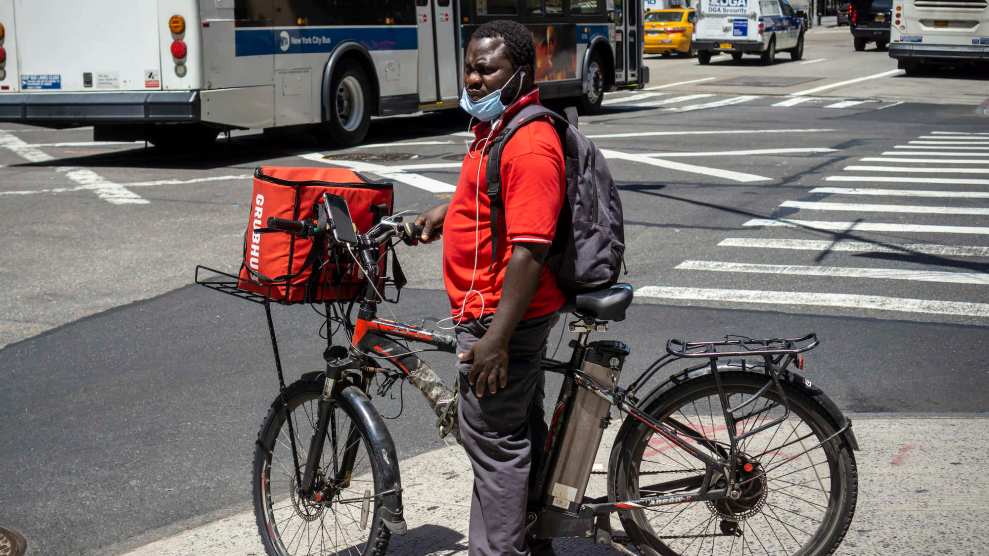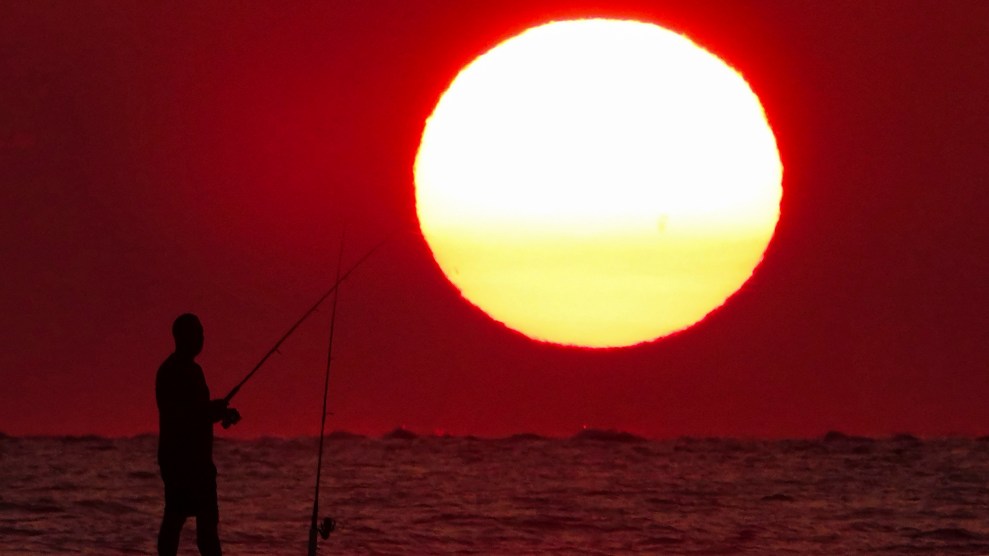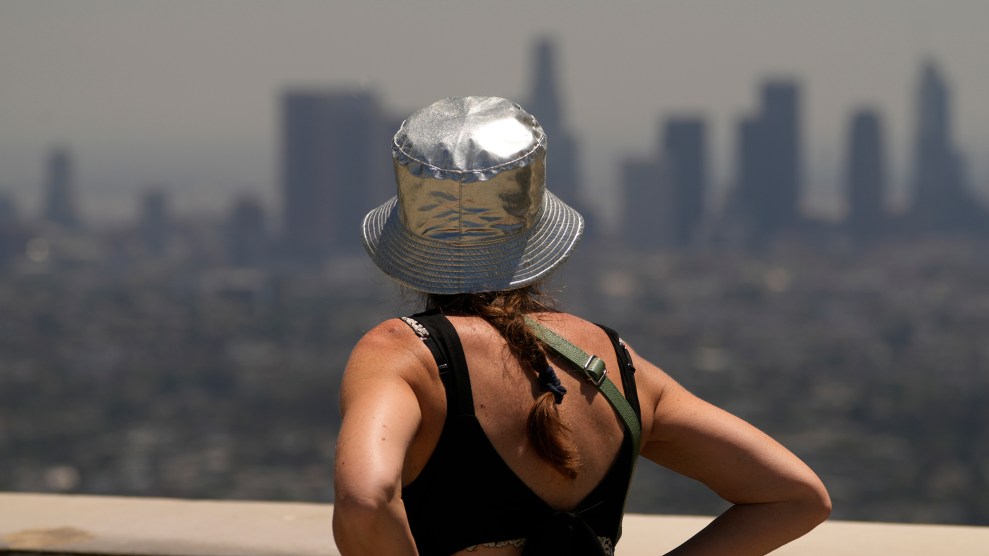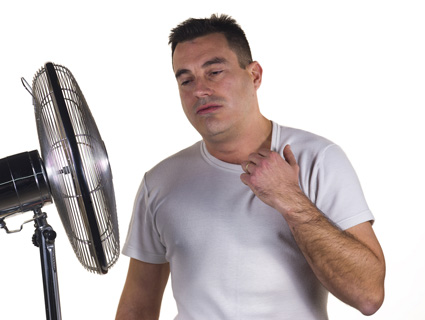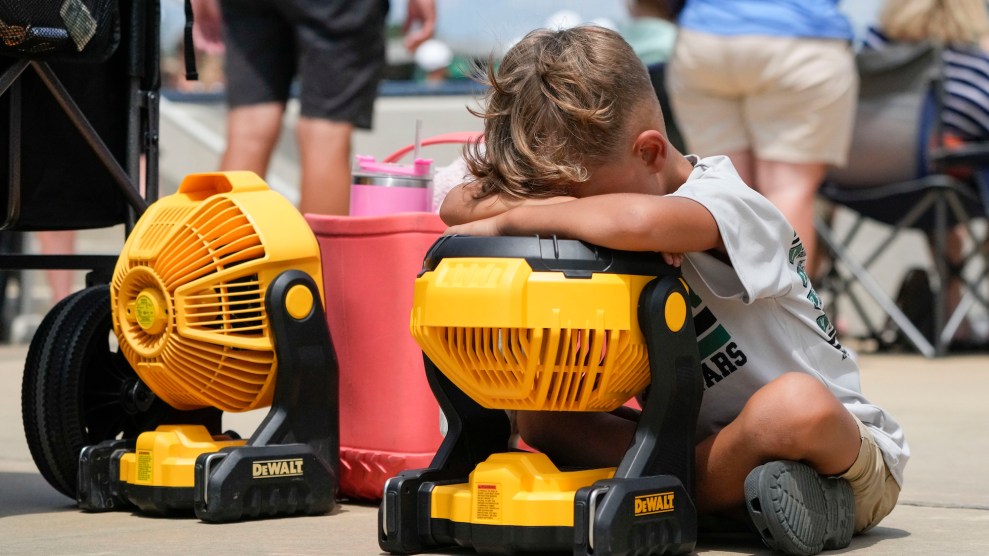
A seven-year-old holds his face to a portable fan to cool off during a Little League tournament in Louisiana during a heat wave. Gerald Herbert/AP
This story was originally published by the Guardian and is reproduced here as part of the Climate Desk collaboration.
It’s been a strange, cruel summer in the United States. From the dystopian orange skies above New York to the deadly immolation of a historic coastal town in Hawaii, the waning summer has been a stark demonstration of the escalating climate crisis—with experts warning that worse is to come.
A relentless barrage of extreme weather events, fueled by human-caused global heating, has swept the North American continent this summer, routinely placing a third of the US population under warnings of severe heat and unleashing floods, fire and smoke upon communities, with a record 15 separate disasters causing at least $1 billion in damages so far this year.
The heat has been particularly withering in places like Phoenix, which had a record 31 consecutive days at temperatures above 110F, while an enormous heatwave across the central swath of the US this week caused schools to be closed in states such as Wisconsin, Colorado, and Iowa and food banks to be shut in Nebraska.
In Miami, which had a record 46 days in a row with a heat index above 100F, there was no respite even in the nearby ocean, with a raging marine heatwave turning the seawater to a temperature more normally seen in hot tubs, raising fears that Florida’s coral reef will be turned to mush.
“It’s been a shocking summer,” said Daniel Swain, a climate scientist at UCLA. “We know most of this is happening because of long-term warming of the climate system so it’s not surprising, sadly, but you still get shocked by these extremes. Records are not just being broken, they are being shattered by wide margins.”
The record temperatures are being driven not only by global heating caused by the burning of fossil fuels but also by the onset of El Niño, a periodic climate event that heats up part of the Pacific Ocean, causing temperatures to spike around the world.
“We have seen an unusual summer and these ‘unusual’ summers will become more and more frequent in the future,” said Katharine Hayhoe, a climate scientist at the Nature Conservancy. Hayhoe said high temperatures, El Niño and natural variability have all combined to create the sort of conditions not seen before by humans. “It’s like an overloaded camel with an extra bale of hay and then some additional weight on top,” she said.
But while extreme conditions could be expected, the events of this summer have still at times seemed otherworldly. In June, smoke from record wildfires in Canada—an area the size of Greece has so far burned in its vast forests—billowed south, smothering New York and Washington, DC, in an ochre haze that brought with it the worst air quality in the world. Visibility shrank, asthmatics wheezed, and people reached for masks not worn since the height of the Covid pandemic.
A freakish tone for the summer was set. In Arizona, it got so hot that the state’s specialized burn center was at full capacity from people who had burned themselves just by falling on to the scorching ground. Even the state’s saguaro cacti, a symbol of the US West, started to collapse in the extreme heat.
In Juneau, Alaska, melting glaciers caused a torrent of water to wash buildings away. Meanwhile, Vermont, seen as a safe, temperate haven from such disasters, saw its state capital, Montpelier, resemble a giant swimming pool after disastrous flooding in July.
California, typically the scene of drought and ever-larger wildfires, faced the unusual threat of a tropical storm last week, with Hilary, the first such storm to ravage the state in decades, causing record rainfall in Los Angeles, felling trees and triggering mudslides. Parts of the desert turned into rapids, with Death Valley pummeled by a year’s worth of rain in a day, just a month after tourists, some jokingly wearing fur coats, posed by a giant thermometer at the national park that read 128F (53C), a near-world record temperature.
The jarring, sometimes surreal, nature of the summer has vexed Joe Biden, who has been keen to tout an upbeat election message of surging clean energy investment, new jobs for former fossil fuel workers and an electric vehicle in every driveway.
“I’ve been to too many disaster areas,” Biden muttered shortly before departing for Hawaii, where he toured the devastation wrought by fires upon the island of Maui. The disaster, the deadliest of its kind in at least a century, claimed at least 115 lives when flames tore through Lahaina, a historic town that was formerly located in a wetland, on 8 August.
More than 1,000 people are still missing following the blaze, which razed much of the town, with search teams combing through the rubble often only finding bones or fragments of bodies.
“I don’t think anybody can deny the impact of climate change any more,” Biden has said of the summer, recounting his own dismay at the plumes of wildfire smoke, the suffering of outdoor workers in the heat and the story of a grandmother who suffered third-degree burns after falling from her wheelchair on to the hot pavement. “Folks, do we really want to pretend these things are normal?” he said.
The repeated climate-driven disasters have started to tear at the fabric of American life this year, with state and federal authorities scrambling to deal with displaced people and major insurers deciding to pull out of California and parts of Florida due to the mounting costs of covering homes menaced by fire and floods.
“We just keep seeing these compound disasters—heat then fire; fire and then flood,” said Jim Whittington, an expert on incident management at Oregon State University. “The response community is just maxed out, there aren’t a lot of additional resources available. The summer should be a wake-up call because our systems and infrastructure are built on assumptions made in the 1950s and 1960s that just don’t exist now. We need a major rethink and need to start planning for worse to come, rather than just responding.”
The majority of Americans are now concerned about the climate crisis, polling shows, with strong support for policies that bolster renewable energy and aid disaster response. But there remains a deep partisan divide on the need to confront, or even acknowledge, the problem, as evidenced by Thursday night’s televised debate between Republican presidential contenders, minus Donald Trump, that saw candidates either deny the existence of the climate crisis or downplay the need to rapidly move away from fossil fuels.
Even a summer as extreme as this one is unlikely to significantly shift this dynamic, Swain said, even though it is likely to be followed by a string of years that are even hotter and more chaotic due to the onward upward march of global temperatures. Greenhouse gas emissions still remain historically high and the impact of El Niño is likely to be even more keenly felt next year.
“This summer is most concerning to me personally and professionally not because it indicates an acceleration of climate change, more that it suggests we are somewhat inured to it,” Swain said.
“This year is shocking and next year may well be worse. This summer will be among the cooler summers this century, it will feel like a remarkably cool summer 30 years from now even though it feels so extreme now. It is quite amazing, in fact it’s mind-blowing when you think about that.”
